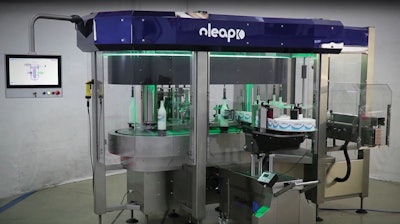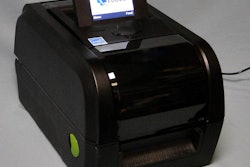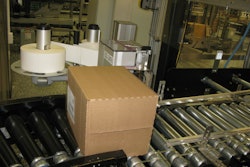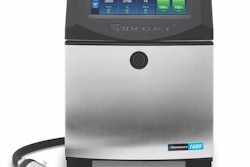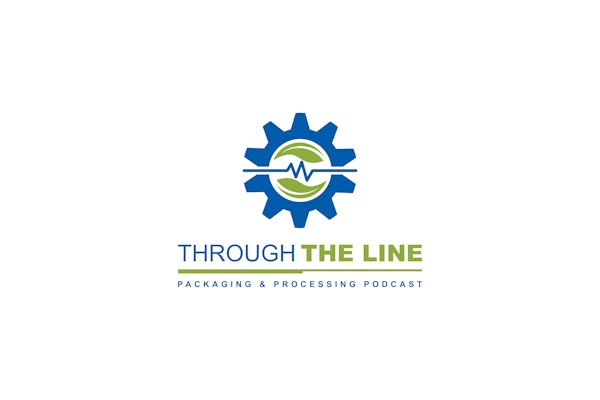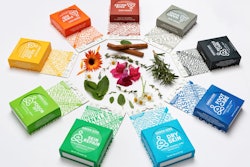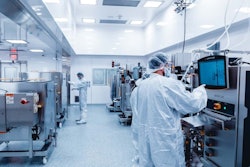Linear servo motor technology continues to find its way into more and more packaging machines these days, so it was no surprise to see it featured by some of the exhibitors at the recent PACK EXPO International 2018 in Chicago. One such exhibitor covered here is Italy’s Makro, which is exploring the use of ACOPOStrak from B&R Industrial Automation.
Makro is a relative newcomer to the packaging machinery scene, having launched about nine years ago. But management has paid close attention to emerging technologies that might be leveraged. Electronics Designer Simone Marcantoni puts it this way: “We’ve been watching ACOPOStrak coming out of development, so when B&R asked if we had any ideas about implementing it in our machines, the concept we came up with is C Leap. That is what we demonstrated at PACK EXPO.”
Making this concept even more intriguing is that it integrates a pair of ACOPOStrak circuits, one directly over the other. The bottom one holds platforms on which the bottles rest. The top one holds the tops of the bottles and applies the downward pressure that holds each bottle firmly on its platform as the bottles are carried past label application stations mounted along the ACOPOStrak. Go to pwgo.to/3966 for a video animation that brings the technology to life.
Like most linear servo motors, the ACOPOStrak relies on components similar to what’s found in a conventional rotary servo motor. But the stator in a rotary servo motor is cylindrical, its magnetic coils are wrapped around it, and the magnetic field that is created causes the shaft to turn—thus producing actuation. This is not the case in a linear servo motor, or “longstator linear motor technology,” as Marcantoni calls it.
“With ACOPOStrak,” notes Marcantoni, “you make the stator linear and the magnetic field runs in a linear manner as opposed to circular like you’d see in a rotary servo motor. The shaft is replaced by shuttles. On the shuttle is a magnet that is attracted by the magnetic field that runs along the linear stator. This is what causes the shuttles, mounted on guides, to move in a linear manner along the stator.”
No fixed bottle platforms
A central idea behind the Makro C Leap concept is that unlike a conventional rotary labeler—whether it applies labels by way of glue or applies pressure-sensitive labels—it has no fixed bottle platforms. Its bottle platforms are mounted on the shuttles, and the shuttles are anything but fixed. The way it operates is that as the shuttles carry the bottles around the track, the bottles pass by stations where labels can be applied. But here’s where it gets interesting, says Marcantoni.
“On a conventional labeling machine,” he points out, “because the distance from one platform to another, which is known as the pitch, is fixed, the size of the label you can apply is equally fixed. But with our C Leap labeler, it’s easy to change the pitch because the bottles are on platforms that rest on the shuttles, and the distance between shuttles—both the bottom ones holding the bottle platforms and the top ones that press down on the bottles—can be adjusted at the touch of a button on the HMI.”
A labeling machine whose pitch can be quickly changed is valuable in today’s marketplace because the CPG companies buying labelers are looking for equipment that can accept a variety of container diameters without missing a beat. The Makro C Leap also makes it possible to send bottles of varying heights into the labeler because the tooling on the upper ACOPOStrak that holds bottle necks is spring-loaded. This is what permits it to accept different bottle heights—within limits, of course.
“These are machines that adapt to each product, instead of running batches of product that conform to the machine setup,” says John Kowal, Director of Business Development at B&R. “According to the Industrial Internet Consortium, the enabling technology for these adaptive machines is the Intelligent Transport System. It’s a non-sequential, track-and-shuttle technology that controls individual products independent of the other products on a production or packaging line. From Consumer Packaged Goods companies to life sciences manufacturers to e-commerce players, everyone is seeking to implement digital business models that match production to individual customer requirements. What’s been missing is cost-effective automated production and packaging of batch size one. Adaptive machine technology fills this gap.”
Another important opportunity the C Leap offers is scalability. If a customer needs greater throughput from the labeler originally purchased, it’s simple enough to lengthen the top-and-bottom tracks and add more labeling stations. It’s this modularity that Marcantoni keeps coming back to as he talks about the technology.
“The synchronized circuits move the bottles between the infeed and outfeed starwheels. The solution offers numerous advantages in terms of modularity. It is possible to expand the track for additional labeling stations, increase the production rate by increasing the number of platforms, change the pitch on the fly—short pitch for short labels, large pitch for long labels.”
Ease of maintenance
The machine’s modularity also pays dividends when it comes to maintenance. “On a more traditional machine, if you have 20 bottle platforms and you need to repair even one you need to shut the whole labeler down,” says Marcantoni. “On the C Leap we can remove a platform or two and perform maintenance but keep the labeler running. It may not be at peak speed, but it’s better than having to shut it down altogether.”
Crucial to just about any automated labeling operation is the ability to wipe down a label to ensure that it adheres smoothly to the round sidewall. It’s fascinating to see how this is accomplished on the C Leap, and again it’s done by way of the track-mounted shuttles. What’s illustrated at 1:47 in the video is how paired shuttles mechanically coupled pull off this bottle rotation motion. One shuttle holds the bottle platform while an auxiliary shuttle reciprocates back and forth on a rack-and-pinion system to cause the bottle platform to rotate.
Worth noting is that Makro is now revising the way in which it rotates the bottle platform. “We’re moving away from the essentially mechanical rack-and-pinion approach,”says Marcantoni. “Instead we’ll use two auxiliary shuttles on the ACOPOStrak in addition to the main bottle platform shuttle. This will bring better control in positioning the platform.”
Another modification now in progress is in the way in which a labeled bottle is discharged from its platform. Currently it’s done with a spring-loaded roller that runs over a mechanical cam, thus causing the neck-holding tooling to lift up from the neck and release the bottle into the starwheel discharge. “Now in development is a method that is less mechanical in nature,” says Marcantoni. “We’re adding an auxiliary shuttle to the top ACOPOStrak circuit that will lift the neck-holding tooling up to release the bottle.”
Marcantoni says the machine on display at PACK EXPO was more of a concept than a piece of commercially available equipment. But commercial installation with a beta customer is expected in Q1 of 2019. “We’ll be applying front, back, and neck pressure-sensitive labels at seven to eight thousand bottles per hour,” says Marcantoni. “So not super high speed, but there will be a variety of label types.”
